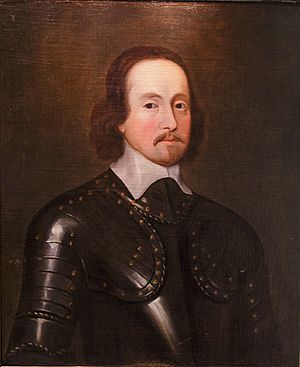Charles Coote, 1st Earl of Mountrath facts for kids

Charles Coote, 1st Earl of Mountrath (born around 1610 – died December 17, 1661) was an important figure in Irish history. He was a nobleman from a family with both English and Irish roots. His father, also named Sir Charles Coote, was an English soldier who settled in Ireland after fighting in the Battle of Kinsale in 1601.
Contents
Early Political Life
Young Charles Coote started his career in politics. He became a Member of Parliament (MP) for County Leitrim. This meant he represented the people of that area in the Irish government. He served as an MP from 1634 to 1635 and again in 1640. This was just before a big uprising known as the Irish rebellion of 1641 began.
Fighting in the Irish Rebellion
Charles Coote's father was a key leader in trying to stop the Irish uprising in 1642. He led attacks in places like Clontarf and County Wicklow. Sadly, many ordinary people died during these attacks. Charles Coote's father was killed in battle while defending Trim Castle in May 1642.
After his father's death, Charles Coote took over. He led some of the King's soldiers against the Irish Confederate army. He was captured while defending a fort in Kildare by an Irish army. He was later set free in 1643 when a temporary ceasefire was agreed upon.
Choosing Sides in the Civil War
Around this time, Charles Coote traveled to England. He joined other Protestants who wanted strict rules against Catholics and wanted the ceasefire to end. Even though a respected leader, Archbishop Ussher, spoke against their extreme views, Coote didn't change his mind.
However, the King did not agree with Coote's demands. Because of this, Coote decided to join the Parliamentarians. These were the people who supported the Parliament in England, not the King. In 1645, the Parliamentarians made Coote the commander of Connacht, a province in western Ireland. Over the next two years, he took control of the northwest part of that area.
The Cromwellian Conquest
In 1649, King Charles I was executed. This event caused many Protestant and Scottish forces in Ulster to join the King's side, leaving Coote isolated. He had to defend Derry during a long siege from March to August 1649. Surprisingly, he even got help from the Irish Confederate army of Ulster, led by Owen Roe O'Neill.
Battles and Victories
After Cromwell's army captured Drogheda, a large force of Parliamentarian soldiers moved north into Ulster. Coote joined them and together they defeated the Scottish Royalists at the Battle of Lisnagarvey.
By early 1650, the Irish Ulster army became active again. Coote was forced to defend his positions. But after getting more soldiers, he attacked the Irish army at Scarrifholis. He won a huge victory, killing over 2,000 soldiers and taking no prisoners. After this, Coote's army tried to capture the strong Charlemont fortress. His soldiers faced heavy losses before the fort finally surrendered.
Opening Up Connacht
With Ulster mostly under control, Coote moved towards Athlone in June 1651. He managed to get past enemy forces and capture the town. Athlone had an important stone bridge over the River Shannon. Taking this town meant that the Parliamentarian army could now enter Connacht for the first time.
Once in Connacht, Coote attacked Galey Castle, which belonged to the Ó Ceallaigh family. The Ó Ceallaighs fought back bravely. For their resistance, they were taken to a stony hill called An Creagán and hanged. This hill became known as 'Cnoc an Chrochaire', which means 'the Hill of the Hanging'. This name was later given to the nearby village, now called ‘Knockcroghery’. Coote then continued his advance westward and besieged Galway in the winter of 1651. Galway surrendered in April 1652.
Coote received a lot of land in the middle of Ireland. This land had been taken from others during the wars.
The Return of the King
After Cromwell died, Coote played a big part in a change of government in December 1659. He took control of Dublin Castle. In February 1660, he sent someone to invite King Charles II to return to Ireland. Coote was a very important person in the special Parliament that met at that time.
When King Charles II was restored to the throne, he made Charles Coote an Earl of Mountrath in 1660. This was a reward for Coote's strong support.
Governing Ireland
In the last few months of his life, Charles Coote was one of the three most powerful men in Ireland. The King appointed him as a Lord Justice of Ireland. He shared this role with Roger Boyle, 1st Earl of Orrery and Sir Maurice Eustace. These three men acted as the temporary government until the Duke of Ormond was appointed as the main leader of Ireland.
However, the three Lords Justice had many disagreements, especially about whether Catholics who had lost their lands should get them back. These disagreements made it hard for them to govern effectively.
Charles Coote built a main family home called Rush Hall near Mountrath. He died from smallpox in 1661 and was buried in Christchurch Cathedral, Dublin.
Family Life
Charles Coote was married twice. First, he married Mary Rushe. Then, he married Jane Hannay. He had children with both of his wives. His son, also named Charles, became the 2nd Earl after him. His second wife, Jane, quickly remarried Sir Robert Reading, 1st Baronet, and had more children.

